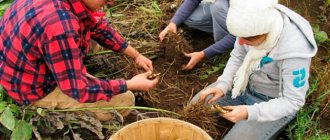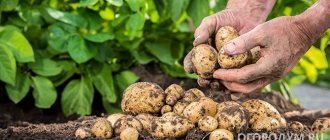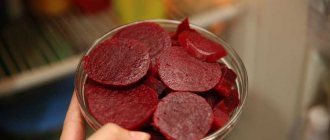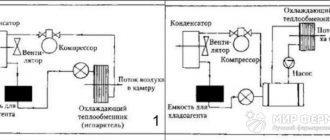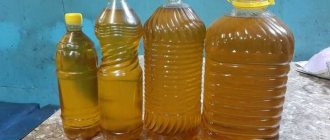This vegetable resembles a sunflower with its flowers, ginger with its roots, and often tastes like potatoes, and is also called “earthen pear” or “Jerusalem root.” In a word, such a rich combination of properties and qualities, combined into a single whole, is what makes Jerusalem artichoke, on the one hand, not very common, and on the other, a simple and unpretentious root vegetable.
Jerusalem artichoke is absolutely not difficult to plant, but when it comes to storing it, questions arise. How and when to collect this miracle of nature, and most importantly, how to preserve it longer, will be discussed.
Jerusalem artichoke: when to dig?
- Experienced gardeners say that it is not worth harvesting the entire crop at once. At the beginning of autumn, you can collect what is already fully ripe and can be consumed immediately. The fact is that Jerusalem artichoke is frost-resistant and is perfectly preserved in the ground, so it can survive frost (and it can withstand even -40°C if covered with grass or leaves, snow or soil) even while remaining in the soil. At the same time, preserving a plant in a cellar is often problematic.
- And yet, if for some reason it is unacceptable for you to leave root crops in the ground, dig them up already in late autumn, somewhere closer to November. The longer the Jerusalem artichoke stays in the ground, the more benefits it will have.
Jerusalem artichoke health benefits
- And vice versa, if dug up in early autumn, it will not have time to accumulate many useful substances in which it is so rich. The best time to harvest is dry weather. Slush, and especially frozen slush, will significantly complicate the work.
- An approximate scheme for harvesting Jerusalem artichoke is as follows. In September-October, you need to dig up tubers as needed. When late autumn arrives, collect part of the root crops for one and a half to two months in order to eat and, if there is livestock, for their feed.
- By the way, if you cultivate Jerusalem artichoke specifically as a fodder crop, then you don’t have to collect it at all - just release the pigs onto the plot, and they will dig the tubers themselves. Then - in winter and early spring - you can use the tubers that have remained overwintered in the ground - they are full of vitamins.
When to dig up Jerusalem artichokes for food. Step-by-step instructions for digging up tubers
The following scheme for digging up tubers is recommended:
- From the beginning of October (or even from mid-September), dig up useful roots for preparing salads and other dishes according to family needs.
- In late autumn, harvest part of the crop for food or animal feed for 1.5-2 months.
- From late autumn until spring harvesting, use wintering tubers (if they can be easily dug up). In winter, the body simply needs vitamins!
- In spring, vitamins are needed even more due to the inevitable seasonal vitamin deficiency of the human body. Therefore, a bed with natural vitamins in the garden will be a great help to health that has weakened over the winter (you will find out what exactly the benefits of Jerusalem artichoke root are for the body and human health here).
Jerusalem artichoke is collected in this way:
- Before harvesting Jerusalem artichoke, you need to cut off all its bushes throughout the entire area. Regardless of whether part of the crop will remain under snow until spring or not.
- Then it’s a matter of technique, well known to everyone from many years of experience in harvesting potatoes. You can dig with shovels, but it’s more convenient to do it with a pitchfork. The forks should not have too wide a space between the teeth (Jerusalem artichoke tubers are much smaller than potatoes). It is easier to dig with a pitchfork, and the tubers are less damaged when working with such a harvesting tool.
Leave a stump 30-40 cm long from the stem of each plant. This shoot will serve as a guide for subsequent actions to dig up tubers in the fall or spring. The shoot will probably almost rot by spring and will not help in extracting tubers even from loose soil, but it will indicate exactly where they are.
The tubers are placed in buckets or small boxes and then transferred to a place of permanent storage. If the soil is dry during harvesting, then drying the crop is not necessary. In case of wet soil, it is necessary to dry the Jerusalem artichoke before storing it. But under no circumstances should you wash the tubers!
From special publications by our experts devoted to the use of such a useful vegetable - the earthen pear, you can learn about how it is used in dried form, how its flowers are used and syrup is prepared from the root vegetable, and we will also tell you what benefits and harm Jerusalem artichoke can bring body.
When to collect Jerusalem artichoke in spring?
- That part of the crop that remains in the ground until spring must be collected before the earth begins to warm up, otherwise the Jerusalem artichoke will begin to germinate, and its benefits and nutritional value will significantly decrease.
- There is another danger of untimely spring harvesting - this is the possibility that the root crops will be damaged by rodent pests. Therefore, before the onset of constant warm average daily temperatures, the crop must be fully harvested.
Jerusalem artichoke - calorie content per 100 g, who is useful
When to dig up Jerusalem artichokes for food. Timing for Jerusalem artichoke harvesting
The harvest of this valuable and unpretentious plant is ready towards the end of autumn.
However, this does not mean at all that the time has come when you definitely need to dig up Jerusalem artichoke. Many gardeners leave it in the ground until spring. What is this connected with? It’s just that Jerusalem artichoke, unlike potatoes and other root vegetables, does not store well in the basement, and it can be difficult to preserve it until the end of winter. But its natural storage in the soil is a gift from nature itself. Jerusalem artichoke is one of those few garden crops that winter well right in the garden. Tubers do not die or deteriorate even in severe frosts.
You just need to lightly cover this place with dry grass or fallen leaves, and the harvest will not go anywhere until spring.
But, however, you don’t have to wait so long and start harvesting in the fall. So, when to dig up Jerusalem artichoke - preferably before the onset of slush and frost, which will simply complicate the task, and you will most likely prefer to give up this business until spring.
But there’s no need to rush either. Many people who like to put things in order around the beginning of October begin to cut off tall shoots of Jerusalem artichoke and throw them outside the site. And in vain! The main accumulation of carbohydrates occurs during the period of October-November. And if you don’t know when to dig up Jerusalem artichokes for food, you can lose the bulk of the harvest, because the root crops will be too small and
tasteless.
Until late autumn, the plant experiences an outflow of nutrients from the leaves and stems to the roots. So if you wait until the right time, you can harvest up to 10 kilograms of harvest from one bush.
To harvest Jerusalem artichokes before the start of winter, you need to cut the stems at a height of 20 cm at the end of November and leave the plant in this position for another two weeks for ripening. And after this you can begin directly to harvest. Experienced gardeners do not collect all the tubers, leaving some for spring harvest. Only in the spring they need to be removed before the soil warms up and the roots sprout new shoots.
Its popular name is “earthen pear”. An unpretentious plant, simple, unappetizing at first glance. This is partly why many people underestimate him. Meanwhile, during the Great Patriotic War, thousands of people were saved from starvation and were able to survive the winter by digging root crops from frozen soil. It turns out that Jerusalem artichoke contains a huge supply of useful vitamins and microelements. In addition, the Israeli artichoke performs a number of useful functions:
- increases immunity;
- Helps control blood glucose levels because contains insulin;
- normalizes blood pressure;
- ensures the removal of waste, toxins, and excess salt;
- strengthens bones;
- enhances potency, normalizes hormonal levels in men;
- soothes the intestines, useful for gastritis;
- increases hemoglobin levels;
- stimulates metabolism;
- improves skin condition if used as masks;
- promotes safe weight loss.
This is such a miracle of the plant world. Planting Jerusalem artichokes in your garden plot is not difficult. Difficulties arise when saving. It is how to store Jerusalem artichoke that will be discussed further.
Jerusalem artichoke: how to dig?
- When you decide on the date for digging up the tubers, cut the shoots approximately 10 days in advance , leaving about 20 cm above ground level. So the Jerusalem artichoke will ripen a little more - and you can take up the shovel. The root crop is dug in the same way as potatoes - the bayonet of the shovel is driven deep and pries up the tubers, digging them up. a fork with a not very wide distance between the teeth for digging
- Just like potatoes, Jerusalem artichokes are placed in buckets or boxes and taken to the cellar for storage or home - depending on how you plan to store the root crops. If the tubers are wet, you should not place them in the cellar without drying them. But you absolutely can’t wash them!
- If you decide to leave a few bushes to dig them up in the spring when the soil warms up, then create a protective layer of hay for them or do not cut such bushes along with the rest.
Digging
Caring for Jerusalem artichokes in the fall after planting
The culture is not whimsical, so after planting in the fall it grows without special care. When favorable conditions are created, problems with culture do not arise. Caring for Jerusalem artichoke in the fall becomes more difficult if the autumn is long and warm and the plant has sprouted young shoots.
Watering schedule
The culture responds well to moderate watering. In summer, it easily tolerates drought. But before wintering, the supply of moisture increases. Water in the morning every 5 days until frost sets in. Water-recharging watering will help the roots deepen. If the Jerusalem artichoke has not sprouted and is at rest, water the bed with the same frequency, at least 10 liters per hole, the water should be cold.
Loosening the soil and hilling
Loosening is a mandatory procedure after autumn planting. Every day for 2–3 weeks, the beds are loosened. These manipulations give oxygen access to the root and destroy weeds. Loosening involves thinning the planting. If the shoots are dense, leave a distance of 35 cm, the remaining shoots are removed. Densely planted Jerusalem artichoke is prone to degeneration.
If the plant is planted on a hill in a ridge, it is constantly trimmed and topped up. If Jerusalem artichoke germinates after autumn planting, the soil is added to the top leaves.
If the planting was carried out on level ground, the procedures for loosening the soil are supplemented by hilling the young plant. It is covered with soil to the top. In 50% of young shoots, they manage to survive until spring. Those sprouts that are frozen quickly recover. The main task in autumn planting care is to preserve the tubers.
Do I need to feed
When laying the beds, complex fertilizers are applied, which should be enough until spring. Before frost, it is recommended to apply products containing nitrogen. Wood ash is scattered on top of the bed. A week before stopping watering, add an infusion of fermented freshly cut grass with bird droppings (1:10).
Is it necessary to prune Jerusalem artichokes for the winter?
Jerusalem artichoke produces a large mass of shoots and leaves. To speed up the ripening process of the root crop, pruning is carried out closer to autumn, around the beginning of September. Early stem pruning is not advisable. Vegetables in the soil will not have time to accumulate a sufficient amount of nutrients and gain the required weight.
In the spring, the growing season of Jerusalem artichoke is aimed at the formation of green mass; the fruits will not be large and will lose in taste. By autumn, the bush begins to wither - this is an indicator of the ripening of the vegetable. By winter, the tops dry out completely, because the plant no longer needs them. Cut the stems 15 cm higher from ground level; in the spring it will be easy to determine where the bush is located.
Preparing for winter
In regions with warm climates, preparation for winter involves cutting off the stems. The plant is not covered for the winter. Tubers are well preserved and do not lose their chemical composition at a temperature of -40 0C. In temperate climates, Jerusalem artichokes are covered with a layer (at least 15 cm) of leaves, peat, sawdust or chopped tree bark. It is recommended to hill up the plant before mulching. In winter, snow is thrown over the crop.
How to store Jerusalem artichoke?
- Storing Jerusalem artichoke in winter is a very problematic task, since it tends to deteriorate very quickly - a few days at room temperature are enough for the tuber to wilt and become unfit for consumption.
- Therefore, you need to store Jerusalem artichoke roots in the cold, for which you use options such as a freezer, refrigerator, basement, balcony.
- In addition, Jerusalem artichoke can be stored in piles, which are essentially shallow pits. Root vegetables are poured into them, alternating their layers with layers of sand or straw, and sometimes even snow is used. And the option described above is to simply leave the tubers in the ground, where they can be stored until the onset of heat, and you can dig them up as needed, if the condition of the soil allows.
Storing root vegetables
How to store Jerusalem artichoke in the cellar in winter?
- The cellar should be humid, and the higher the humidity, the better for the preservation of the tubers. Ideally it should be at least 90% . A fairly low temperature is also required - no higher than 0°C.
- Root vegetables are sprinkled with earth (you can also use wet sand) and placed in spacious boxes, preferably wooden rather than plastic.
- Capacious bags are also suitable, again, made of natural burlap, and not made of cellophane. In this form, Jerusalem artichoke can be stored for several months. In the same way, you can store root vegetables on the balcony.
How to store Jerusalem artichoke in the refrigerator?
- This is a short-term storage option, approximately 2 weeks. The main thing is to choose a container that would provide the tubers with the necessary humidity and inaccessibility of air.
- This can be a closed container, a plastic bag, or any other container that provides the necessary conditions. As a last resort, you can even simply wrap the Jerusalem artichoke in a damp cloth and put it in the bottom drawer. This way you can briefly store a small amount of Jerusalem artichoke, which you plan to use in the near future.
Optimal season
It is not necessary to harvest the entire crop in the fall; it is better to leave some of it in the ground until spring. Moreover, the tubers have a short shelf life, no more than a month. It is for this reason that we do not often see it on store shelves; the complexity of transportation and storage does not allow us to see Jerusalem artichoke as a frequent guest on our table.
Attention! Jerusalem artichoke is very picky about storage conditions. No matter how hard you try, you won’t be able to preserve your crop reserves all winter; it will still deteriorate and rot.
Tubers tolerate winter well in the soil without losing their beneficial properties, and even vice versa. After winter frosts, inulin, which is part of Jerusalem artichoke, is converted into fructose, which increases the nutritional value of the root crop. After wintering, the tubers become sweeter, which is not to everyone’s taste.
Let's consider whether it is possible to collect Jerusalem artichoke tubers in the spring. In the spring, as soon as the soil begins to thaw, it will be possible to dig up Jerusalem artichokes in the required quantities. The main thing is not to leave it until new growth begins and the beneficial properties of the tubers decrease.
Tubers dug up in the spring can be immediately used for planting by cutting them into pieces (what is the time frame for planting Jerusalem artichoke?). Not only root vegetables are used for food; leaves and inflorescences of plants can be collected during the flowering period to make tea.
How to freeze Jerusalem artichoke?
- Jerusalem artichoke can be frozen in the same way as other vegetables. The tubers must be cleaned , washed thoroughly and dried. Grind the way you intend to use it: cut into pieces or grate, you can do both.
- Some housewives use a 10-minute blanching in whey from milk and cottage cheese before freezing . Then place in portions in plastic bags or containers and store in the freezer. Defrost slowly by placing in cold water.
When to Harvest
Jerusalem artichoke is not suitable for long-term storage, so the tubers can be dug up gradually in small portions as needed. The ripening of a vegetable is determined by the withered leaves of the plant. The problem can only arise after the onset of frost. It is difficult to remove an earthen pear from frozen soil.
Jerusalem artichoke root (Photo from the site https://veganolife.ru)
Overwintered Jerusalem artichoke will not only not spoil, it will be even softer and sweeter than the one dug up in the fall. Ground pears collected in the spring are easier to peel, cut into pieces or grate.
After digging, Jerusalem artichoke is stored for no more than 1-1.5 months; after this period, due to loss of moisture, the tubers change their appearance and begin to partially rot. In the spring, the earthen pear must be collected in time after the snow has melted and the ground has thawed, until the plants begin a new growing season.
In winter and early spring, when the human body needs vitamins as much as possible, you can use a wintering earthen pear if the ground is not very frozen.
How to dry Jerusalem artichoke?
- You can dry Jerusalem artichoke at home just like any other fruit. For example, outdoors, why cut the tubers into thin slices and lay them in one layer on a flat surface.
First, let's cut
- Needless to say, the fruit should be free of dents and damage. Take it outside and place it out of direct sun. And it is also necessary to protect the dryer from flies and midges, for which you can cover it with a layer of gauze on top.
- The next drying option is oven . To begin with, the tubers are boiled in salted water with a teaspoon of soda for about 10 minutes. Then filter and cool. After this, the Jerusalem artichoke should be laid out on a baking sheet or on a fine wire rack and kept for about three hours in an oven heated to 50°C, stirring occasionally.
- The third way is to use an electric dryer , placing the tubers on the racks and turning on the device for 4 hours. Place dried Jerusalem artichoke tubers in a container and place in a dry, unlit place - this way it will be stored for a year. Part of the dry product can be immediately ground in a coffee grinder - you will get a natural energy drink, which all you have to do is pour boiling water over it and, after it has steeped, drink it instead of coffee.
How to eat Jerusalem artichoke: delicious recipes
Remember in the movie “Girls” there were 80 potato dishes mentioned? Jerusalem artichoke, of course, is not so popular, but there are also many recipes. One thing: in fresh, unprocessed form, Jerusalem artichoke can cause increased gas formation in the intestines. Therefore, in catering establishments you will not find salads with fresh Jerusalem artichoke. For those planning to try Jerusalem artichoke for the first time, we recommend starting with a small portion.
Boiled Jerusalem artichoke
500 g tubers, 1 onion, salt, pepper, herbs (any) - to taste.
Peel the tubers and cut into large pieces. Soak in cold water with lemon juice for 15 minutes.
Place the tubers in a saucepan, add water and salt. Add onion and spices to the water to taste. Bring to a boil, reduce heat, cover the pan with a lid and cook for 10–20 minutes (depending on the size of the tubers) until tender.
Sprinkle the finished Jerusalem artichoke with finely chopped herbs (dill, parsley, cilantro or green onions) and serve as a side dish or as a separate dish.
Fried Jerusalem artichoke tubers are no less tasty than potato tubers. But it cooks faster and retains more benefits.
Fried Jerusalem artichoke
500 g tubers, salt, pepper, herbs (any) - to taste.
Wash the Jerusalem artichoke tubers and remove the skin. Cut into small slices or circles, soak in cold water with lemon juice for 15 minutes.
Heat the frying pan. Pour in some vegetable oil. Fry the tubers, stirring occasionally, for 3-4 minutes until a tender golden crust forms. Salt and pepper. Turn off the heat, close the lid and leave for another 3 minutes.
Sprinkle with herbs before serving.
Jerusalem artichoke baked in the oven
500 g tubers, 1 tbsp. a spoonful of olive oil, salt, pepper, herbs - to taste.
Wash, peel and soak the tubers in cold water for 15 minutes.
Toss the tubers with olive oil, salt and pepper. Place the tubers on a baking sheet and place in the oven, preheated to 220 °C. Bake for 1 hour.
Sprinkle with chopped parsley and serve hot.
Jerusalem artichoke baked with onions, garlic and herbs
400 g Jerusalem artichoke tubers, 5 onions, 3-4 cloves of garlic, 50 g olive oil, 1 small bunch of herbs (parsley, cilantro or dill), 1 teaspoon of dried herbs, salt and black pepper to taste.
Wash, peel and soak the tubers in cold water for 15 minutes.
Peel the onion and cut into slices. Peel the garlic cloves and finely chop them. In a bowl, mix the oil with herbs, herbs, salt and pepper. Add Jerusalem artichoke and onion there. Stir.
Preheat the oven to 200°C. Place vegetables on a baking sheet and place in the oven for 30–40 minutes.
Serve hot.
How to store Jerusalem artichoke leaves?
- To preserve the foliage for many months, it must be thoroughly dried. It is best to do this by placing them in the hottest room, which is also quite dry. Be sure to ensure that the leaves are not exposed to direct sunlight - this can contribute to the destruction of vitamins.
- Experts do not recommend using an electric dryer, because when drying, some of them crumble and fall through the grate, forming dust and debris.
- Dried leaves can be poured into a glass jar or other container and closed tightly. It’s even better to collect dry leaves in a linen bag and tie it tightly. Natural fabric will promote the “breathing” of inflorescences and leaves, from which, as well as from the tubers themselves, tea can be brewed.
Can make delicious tea
How to preserve Jerusalem artichoke for the winter?
- Jerusalem artichoke can be used in preservation - this is also one of the ways to preserve its properties and enjoy it in the winter.
- It enhances the taste of dishes, giving them a certain piquancy. The root vegetable is good in winter salads with vegetables; you can quickly make jam from it, jam with the addition of plums, or make a dessert by adding pumpkin and lemons.
- Jerusalem artichoke can be fermented and pickled - in a word, used in preservation in large quantities and in a variety of ways.
How long does Jerusalem artichoke last?
- Tubers can be stored in the bottom drawer of the refrigerator for a maximum of a month, and more often – 2-3 weeks. If you freeze Jerusalem artichoke, the shelf life will be 2 months, in the basement - up to 2 months.
- Jerusalem artichoke left in the ground will be usable throughout the winter. In dried form, the shelf life is one to one and a half years.
Useful articles for gardeners:
- When to harvest onions
- How to properly care for bulbous flowers
- When to remove leeks from the garden for storage
- When to dig up gladioli in the fall for the winter after flowering
- When to dig up tulip bulbs after flowering
Jerusalem artichoke: special signs
In central Russia, Jerusalem artichoke grows in many gardens and is most often perceived by farmers as a beautiful weed - 2-2.5 meters high, looks like a sunflower, and by the end of the growing season (late September) it becomes a hedge. It does not require any care; it is not damaged by diseases and pests, like an introduced species (a native of another continent). Winters well. This knowledge about the earthen pear is usually exhausted.
But even a century or two ago, before the advent of the potato era, Jerusalem artichoke occupied an important place in the diet of the common people. Europeans first became acquainted with it in North America. Actually, it received one of its names - Jerusalem artichoke - from the name of the Indian tribe "Tupinamba". Already at the end of the 17th century, settlers to North America made up to 40% of their diet in autumn and winter.
Another name for Jerusalem artichoke, accepted in the English-speaking world, is “Jerusalem artichoke.” This is how Italian immigrants to the USA dubbed it - for its external similarity to sunflower, which in their language was called “girasol”. Well, from here it was not far to “Jerusalem” (Jerusalem).
There is some truth in this name - Jerusalem artichoke actually tastes vaguely like an artichoke. And also asparagus. Only unlike these two plants, the earthen pear is extremely productive: the bush can produce up to 70-150 tubers, or 2-3 kg. The average yield of this crop per 1 acre reaches 400-600 kg - this is 2-3 times higher than the yield of its main competitor - potatoes.
The extraordinary yield of Jerusalem artichoke at one time interested the young Soviet government, and, as under Peter I and Catherine I, it began to plant this crop under pressure. Even the famous scientist and breeder Nikolai Vavilov had a hand in this, and in the early 1930s he developed several new varieties of Jerusalem artichoke. But suddenly the matter - huge fields with earthen pears - came to a standstill. It turned out that under Russian conditions large bunches of Jerusalem artichoke are not stored.
Poor storage is a sad feature of this culture. Unlike potatoes, after digging, a Jerusalem artichoke tuber does not form a crust, which prevents rapid drying and serves as a barrier for microorganisms. Maximum 2 weeks - this is usually the shelf life of an earthen pear, even in the refrigerator.
But its tubers are perfectly stored in the ground. In Western European countries (England, France and Germany, where this crop is most popular), even in January-February a gardener can go and dig up tubers. In Russia, at this time, the ground can only be broken with a crowbar.
This restriction significantly influenced the spread of Jerusalem artichoke in Russia. The season for digging it out is two months (until mid-November), and even then in small “portions.”
Jerusalem artichoke: photo of the plant
Jerusalem artichoke - what the tuber and all other parts of the plant look like. In the cross-section of an “earthen pear”, Jerusalem artichoke flowers look like this:
Jerusalem artichoke on wooden table.
The stems are long and the leaves are similar to sunflower leaves.
Jerusalem artichoke root system
Jerusalem artichoke varieties
There are more than 300 varieties of Jerusalem artichoke, including hybrids and wild varieties. In the CIS countries, the most commonly used types are: Skorospelka, Interest, Leningradsky, Krasny, Nakhodka, Volzhsky 2, Vylgortsky.
Early ripening - oval-shaped tubers, white in color. Blooms in September. Tolerates frosts well. Suitable for mechanized cleaning.
Of interest is a silage-tuberous type of Jerusalem artichoke, which grows up to 3 meters and has from one to three stems, blooms in the third ten days of September. Tubers of the Interest variety are large, 55 - 75 g, and are characterized by increased sugar content.
Nakhodka is a tall variety, growing more than 3 meters in height. The tubers are white, pear-shaped, weighing 44 - 50 g. Harvesting can be done mechanically.
The Leningrad variety is distinguished by its bushy form with branching. The tubers are white in color and oblong in shape. The tubers are collected in the spring.
Volzhsky 2 – pear-shaped. A feature of the variety is resistance to dry periods and resistance to frost. It is possible to harvest the crops mechanically.
The Vylgort variety is distinguished by the appearance of its tubers. They are oval and yellow in color. The bush of the plant is spreading. Tolerates spring frosts well and is also resistant to winter frosts. According to biologists, in conditions of severe winter frosts, tubers are preserved up to 69 - 100%.
